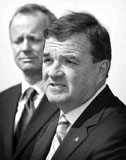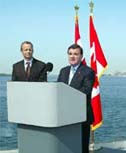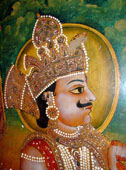North of the lakes : what is the Egmont Group, and why is Dalton McGuinty going to India?
Jul 11th, 2006 | By Counterweights Editors | Category: Canadian Provinces HONEY HARBOUR, ON. Nothing is supposed to happen up here in the summer. But of course it does. This can even be a good time to sneak through somewhat strange messages in the news.
HONEY HARBOUR, ON. Nothing is supposed to happen up here in the summer. But of course it does. This can even be a good time to sneak through somewhat strange messages in the news.
So Canadian federal finance minister Jim Flaherty has announced that a mysterious international financial watchdog called the Egmont Group will be establishing a new permanent headquarters in Toronto. And Ontario premier Dalton McGuinty has made known that he will be paying an official visit to India (and Pakistan) in January 2007.
What is the Egmont Group anyway?
 The Egmont Group was apparently set up 11 years ago, to co-ordinate “the still-nascent fight against money laundering and terrorist financing” in 101 countries, “similar to the way the 83-year-old International Criminal Police Organization” [or “Interpol”] helps police forces around the world to “co-operate and share data.”
The Egmont Group was apparently set up 11 years ago, to co-ordinate “the still-nascent fight against money laundering and terrorist financing” in 101 countries, “similar to the way the 83-year-old International Criminal Police Organization” [or “Interpol”] helps police forces around the world to “co-operate and share data.”
The group is named after the Egmont Palace in Brussels, where it all began in 1995. Up to now the group has had no permanent home or secretariat. But Stephen Harper’s new Canadian federal government is kicking in $5 million, to help a four-to-six-person Egmont Group permanent secretariat set up shop in Toronto – Canada’s current largest and most legendary “city with the heart of a loan shark.”
 This does seem one of those government announcements that is more interesting for its symbolism than its substance. Four to six new jobs in the Toronto financial sector is … well, not very many. It is said that the new Egmont Group secretariat will probably attract some fresh international financial-meeting business for the local tourism sector. But even if this is true, it seems unlikely to have any dramatic (or even measurable?) impact.
This does seem one of those government announcements that is more interesting for its symbolism than its substance. Four to six new jobs in the Toronto financial sector is … well, not very many. It is said that the new Egmont Group secretariat will probably attract some fresh international financial-meeting business for the local tourism sector. But even if this is true, it seems unlikely to have any dramatic (or even measurable?) impact.
As a matter of symbolism, however, the increasingly vaunted strategic mind of Prime Minister Harper has discovered another rich vein of silver. On the most visible surface, it flatters the strategic Toronto financial sector’s vanity that it will now be playing host to such a conceivably eventually important international financial watchdog. And, just a little deeper, it helps offset any offshore or other impressions that there may be “money laundering and terrorist financing” actually going on in this particular location itself.
 However you look at it symbolically, in any case, the new Egmont Group secretariat in Toronto seems bound to be a good thing. It also shows that Canada is pulling its weight in the new global-village struggle against money laundering and terrorist financing. (And hopefully someone paid to study such signs will be doing their job in Washington.) And it shows that the Harper federal government from Alberta is doing something for the capital city of Ontario.
However you look at it symbolically, in any case, the new Egmont Group secretariat in Toronto seems bound to be a good thing. It also shows that Canada is pulling its weight in the new global-village struggle against money laundering and terrorist financing. (And hopefully someone paid to study such signs will be doing their job in Washington.) And it shows that the Harper federal government from Alberta is doing something for the capital city of Ontario.
Finally, lest anyone think that the Harper government’s finance minister, Jim Flaherty from Ontario (a.k.a. federal minister for the Greater Toronto Area), is too obsessed by his own backyard, an Egmont Group cousin known as the Financial Action Task Force (FATF) will be holding the “First Plenary Meeting of FATF-XVIII” early this coming October in “Vancouver, Canada.” (Oh, and what is it that the Egmont Group actually does again? If you really must know try this … or this … or this.)
Dalton McGuinty’s passage to India …
 As many resident local observers like to point out, Ontario Liberal premier Dalton McGuinty as a success story is not easy to explain.
As many resident local observers like to point out, Ontario Liberal premier Dalton McGuinty as a success story is not easy to explain.
He does look a lot like Norman Bates in the Alfred Hitchcock movie, Psycho. His public persona on TV is congenitally awkward. He has no deep (or even shallow) ideological message. And, in the gotcha’ games some branches of the mass media love to play, he has broken a lot of “promises” he made in his election campaign.
And yet on the current numbers there seems a good enough chance that he will also finally win Ontario’s next (and first fixed-date) election on October 4, 2007 too. If you have been watching closely, the beginnings of a more cosmic explanation may be starting to appear.
In 25 words or less, Dalton McGuinty may be the only Ontario politician active today who is actually interested in Ontario. And at this juncture in the now quite long saga of Canada’s most populous province, that could prove a big strength.
More than any other political leader at Queen’s Park this summer, at least, Mr. McGuinty sometimes does seem to possess some authentic convictions about and even honest admiration for the sovereign Ontario people today. His convictions draw on an almost tight grasp of the regional past, and a few plausible instincts about the brave new world that lies ahead.
They of course don’t cover all the bases in either the old or the new Ontariario (as they used to say at Queen’s Park back in the 1960s). But they may just cover enough ground to keep the McGuinty Liberals in office for a while yet. The July 6, 2006 announcement that Premier McGuinty will visit four Indian and three Pakistani cities between January 14 and 26, 2007 – “on a 12-day mission to boost trade and investment” – seems a small case in point.
Cultivating the new Liberal multiculturalism …
 The story in the official press release runs something like this: “Ontario’s diversity is one of our province’s greatest strengths – we speak every language and understand every market,” said Premier McGuinty. “These business missions to India and Pakistan will help us build relationships with our international friends and partners to build a stronger, more prosperous Ontario.” … Economic Development and Trade Minister Joseph Cordiano and Small Business and Entrepreneurship Minister Harinder Takhar will join Premier McGuinty on the missions, along with senior representatives of Ontario companies and organizations … Ontario’s two-way goods trade with India and Pakistan has nearly doubled over the past five years, reaching a combined $1.2 billion in 2005.
The story in the official press release runs something like this: “Ontario’s diversity is one of our province’s greatest strengths – we speak every language and understand every market,” said Premier McGuinty. “These business missions to India and Pakistan will help us build relationships with our international friends and partners to build a stronger, more prosperous Ontario.” … Economic Development and Trade Minister Joseph Cordiano and Small Business and Entrepreneurship Minister Harinder Takhar will join Premier McGuinty on the missions, along with senior representatives of Ontario companies and organizations … Ontario’s two-way goods trade with India and Pakistan has nearly doubled over the past five years, reaching a combined $1.2 billion in 2005.
Of course, it is also true that substantial numbers of the early 21st century sovereign Ontario people actually come from India and Pakistan, and will no doubt be pleased to see the premier paying the same kind of homage to the old countries that they do themselves, from time to time. Conveniently enough, Dalton McGuinty’s gently reforming Ontario government has an official representative of this subset in today’s regional community to take along on the trip – in “Small Business and Entrepreneurship Minister Harinder Takhar.”
 “Diversity” more generally is similarly a key theme of Mr. McGuinty’s very up-to-date Ontario people. He himself has an Irish name – reflecting the heritage of the original “Others” on the old anglo-North-American family farm frontier of the 19th century. And then his almost surprisingly successful “Economic Development and Trade Minister Joseph Cordiano” will be going to India (and Pakistan) in the dead of the next Canadian winter too. And Mr. Cordiano reflects the already somewhat dated heritage of the non-anglo (and non-franco) Europeans, who moved to the rising cities of Canada’s most populous province in the 20th century.
“Diversity” more generally is similarly a key theme of Mr. McGuinty’s very up-to-date Ontario people. He himself has an Irish name – reflecting the heritage of the original “Others” on the old anglo-North-American family farm frontier of the 19th century. And then his almost surprisingly successful “Economic Development and Trade Minister Joseph Cordiano” will be going to India (and Pakistan) in the dead of the next Canadian winter too. And Mr. Cordiano reflects the already somewhat dated heritage of the non-anglo (and non-franco) Europeans, who moved to the rising cities of Canada’s most populous province in the 20th century.
The McGuinty Liberal Ontario people are almost certainly even ready to embrace the increasingly exotic “New Mtis” – or “halfbreeds” in the vulgar old anglo language – that the new multicultural regional society of the 21st century is inevitably starting to spawn in all the city-regions of the province today. And it is intriguing that the weekend after the official provincial government trip to South Asia was announced, the Toronto Star ran an interesting piece called “Are we all going to be latte? – by “Andrew Chung, Staff Reporter.”
 Mr. Chung’s piece revealed that: “As one of the world’s most ethnically diverse cities continues its long simmer as a racial and cultural melting pot, there will be more children … who blend traditions that were once locked into geographical and ethnocentric isolation … They are the New Mtis.” (The Old Mtis, for those who may have forgotten, were the mixed-race children of the northern “Indian-European” fur trade – in another local sense of “Indian,” of course – that first took modern Canada from coast to coast to coast, in the 17th and 18th and earlier 19th centuries.)
Mr. Chung’s piece revealed that: “As one of the world’s most ethnically diverse cities continues its long simmer as a racial and cultural melting pot, there will be more children … who blend traditions that were once locked into geographical and ethnocentric isolation … They are the New Mtis.” (The Old Mtis, for those who may have forgotten, were the mixed-race children of the northern “Indian-European” fur trade – in another local sense of “Indian,” of course – that first took modern Canada from coast to coast to coast, in the 17th and 18th and earlier 19th centuries.)
While keeping the old fires burning too …
 All this would be impressive enough by itself, no doubt. But what finally makes Dalton McGuinty’s Ontario people of today so conceivably potent politically is how they also link up with the older anglophone regional past. (For good measure, they play a similar trick with the older francophone regional past as well. But set that aside for now.)
All this would be impressive enough by itself, no doubt. But what finally makes Dalton McGuinty’s Ontario people of today so conceivably potent politically is how they also link up with the older anglophone regional past. (For good measure, they play a similar trick with the older francophone regional past as well. But set that aside for now.)
In a tried and true Old Ontario style, Mr. McGuinty’s Irish name has not blinded his vision of how quite a lot of Ontario today is still a spiritual descendant of the now fallen greatest empire since Rome, on which the sun once “never dared to set” (as the great Canadian Liberal from Ontario Lester B. Pearson put it, with suitable whimsy, in his memoirs). Mr. McGuinty may even have read the still intriguing local Toronto historian Percy Robinson, who reported as recently as the 1930s that Ontario was “the most British of all the Provinces” in Canada.
 (And if your own summer reading this year has already included Anna Jameson’s Winter Studies and Summer Rambles in Canada – a sharp-witted genteel British lady’s surprisingly engaging account of her adventures in what is now called Ontario, from the early winter of 1836 to the fall of 1837 – the depths of the province’s old British imperial past will have been brought home to you in an especially urgent way.)
(And if your own summer reading this year has already included Anna Jameson’s Winter Studies and Summer Rambles in Canada – a sharp-witted genteel British lady’s surprisingly engaging account of her adventures in what is now called Ontario, from the early winter of 1836 to the fall of 1837 – the depths of the province’s old British imperial past will have been brought home to you in an especially urgent way.)
Here the premier’s forthcoming trip to the old brightest jewel in the crown of the empire in India and Pakistan also serves very well, in reassuringly stroking many still only slightly hidden depths among key sectors of those who will be voting on Thursday, October 4, 2007. When Mr. McGuinty talks about building “relationships with our international friends and partners” in these two places he is signaling something more than a keen eye for fresh economic opportunities in a developing world that has actually started to develop at last.
 He is equally vaguely alluding to still strangely potent memories of Old Ontario parents and grandparents, and beyond. They recall, e.g., the days when the Diwan of Bahadur from Old India, Sir T. Vijayaraghavacharya, officially opened the Canadian National Exhibition in Toronto, on August 28, 1926. (And then gave a speech to the Empire Club in Toronto – as he would yet again, at the end of the Second World War in 1945.)
He is equally vaguely alluding to still strangely potent memories of Old Ontario parents and grandparents, and beyond. They recall, e.g., the days when the Diwan of Bahadur from Old India, Sir T. Vijayaraghavacharya, officially opened the Canadian National Exhibition in Toronto, on August 28, 1926. (And then gave a speech to the Empire Club in Toronto – as he would yet again, at the end of the Second World War in 1945.)
“History has many cunning passages,” as T.S. Eliot said. And one minor regional case in point is the story of how the old empire on which the sun never dared to set in the 19th and earlier 20th centuries helped prepare Ontario for the new global village in the later 20th and early 21st centuries – as much of a sordid dead end as it was in so many other ways as well, no doubt.
 Hopefully, someone in Dalton McGuinty’s office at Queen’s Park has also been reading Pankaj Mishra’s report on “The Myth of the New India” in The New York Times. With a somewhat eery sense of timing, it too appeared on July 6, 2006Â – the very same day that the McGuinty-Cordiano-Takhar trip to India and Pakistan was announced in Toronto.
Hopefully, someone in Dalton McGuinty’s office at Queen’s Park has also been reading Pankaj Mishra’s report on “The Myth of the New India” in The New York Times. With a somewhat eery sense of timing, it too appeared on July 6, 2006Â – the very same day that the McGuinty-Cordiano-Takhar trip to India and Pakistan was announced in Toronto.
Mr. Mishra seems to be suggesting that anyone in North America who really wants to develop new business opportunities in South Asia is going to have to be very careful and patient. But it is conceivable that Premier Dalton McGuinty and his early 21st century people of Ontario may finally qualify in this context too. (And, to wrap everything up, now the India train bombings in Mumbai – formerly Bombay – on July 11, 2006 strike another vaguely related sad but familiar note. The global village really is much smaller than it used to be.)
